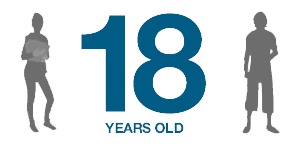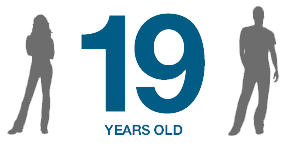The legal drinking ages in Canada are:

Alberta
Manitoba
Quebec

British Columbia
New Brunswick
Newfoundland and Labrador
Northwest Territories
Nova Scotia
Nunavut
Ontario
Prince Edward Island
Saskatchewan
Yukon
Legal Drinking Age in Canada
In Canada, each province and territory defines the legal drinking age. This regulates who can purchase, possess, consume and supply alcohol. Canada’s drinking-age laws have a significant impact on youth alcohol-related harms. For more information, please refer to The Impact and Effectiveness of Minimum Legal Drinking Age Legislation in Canada.
Alcohol Pricing in Canada

In Canada, alcohol is taxed based on excise duty rates for each type of beverage. This taxation is an effective way of controlling the availability and consumption of alcohol. It also helps support a culture of moderation. In general, higher prices mean lower consumption, which helps reduce potential risks and harms.
Based on existing Canadian examples of best practices, the National Alcohol Strategy Advisory Committee (NASAC) recommended that liquor boards and commissions:
- Apply Social Reference Prices (SRPs) to all types of alcoholic beverages;
- Ensure SRPs reflect the alcohol content of drinks within each major beverage class;
- Regularly review, maintain and update the value of SRPs relative to provincial consumer price indexes; and
- Close existing loopholes that allow the sale of alcohol below SRPs.
Enhanced Alcohol Container Labels

Bottles, cans and other alcohol container labels in Canada are not required to display nutrition information, health warnings, standard drink information or low-risk alcohol drinking guidelines. This information would help people make more informed decisions about their alcohol consumption.
Evidence also suggests that enhanced alcohol container labels:
- Are supported by the public;
- Can improve consumer knowledge of alcohol-related risks; and
- May help people decrease the amount of alcohol they purchase and consume.
Heading
Enhanced Alcohol Container Labels: A Systematic Review (Report at a Glance)
Summarizes key findings from the technical report of the same name that analyzes the published research on alcohol labels with nutrition information, health warnings, standard drink information and low-risk drinking guidelines.
Heading
Enhanced Alcohol Container Labels: A Systematic Review [report]
Analyzes the published research on alcohol labels with nutrition information, health warnings, standard drink information and low-risk drinking guidelines. Key findings show alcohol drink labels with this information improve consumer...
Municipal Alcohol Policies and Initiatives

A municipal alcohol policy provides guidance on running safer events on municipally owned or managed property where alcohol is available. These venues include festivals, sport stadiums and community centres.
These policies can:
- Help keep neighbourhoods safe and enjoyable;
- Address concerns about the risks and liability related to alcohol;
- Set community expectations about alcohol consumption;
- Foster community ownership through engagement;
- Set conditions about the availability and access to alcohol; and
- Support healthy lifestyles through community groups.
For more information about municipal alcohol policies, please see Municipal Alcohol Policy in Ontario: A Public Health Approach, The Nova Scotia Municipal Alcohol Project and The Municipal Alcohol Policy Program in British Columbia.
Resources on this page
Partner organizations have supplied some of the resources on this page. CCSA cannot vouch for the accuracy or currency of the information in these resources. Inclusion of a resource on this page does not imply endorsement or authorization by CCSA.
Alcohol and Risk
If you have decided to drink alcohol, drinking it in moderation can help to lower the risks of alcohol-related harms. Canada’s Low-Risk Alcohol Drinking Guidelines can support individuals to make informed choices about alcohol consumption and reduce the short- and long-term health risks.
Canada’s Low-Risk Alcohol Drinking Guidelines are intended for Canadian adults aged 25–65 who choose to drink alcohol. The related resources below also provide advice for youth, young adults, older Canadians and other priority populations.
Resources to educate the public about low-risk alcohol consumption.
Resource | Description | Organization |
|---|---|---|
| Cancer and Alcohol (LRDG Summary) | Provides information on the relationship between alcohol consumption and the risk of developing cancer. | Canadian Centre on Substance Use and Addiction |
| Women and Alcohol (LRDG Summary) | Provides information on the risks and harms of alcohol consumption for women. | Canadian Centre on Substance Use and Addiction |
| Knowing Your Limits with Alcohol: A Practical Guide to Assessing Your Drinking | Provides tips and guidance for individuals considering changing their alcohol consumption to a lower-risk level. This self-help resource can be used independently or with the guidance of a healthcare provider. | Canadian Centre on Substance Use and Addiction |
Screening
Screening helps healthcare and allied professionals identify individuals who drink alcohol beyond low-risk levels. Screening tools typically involve a series of questions about a person’s self-reported use of alcohol and other relevant clinical information. Screens vary in length, target population and the substances or health issues for which they screen. Assessment for alcohol use disorder should always be conducted by qualified clinicians.
For additional information about alcohol screening or to share additional resources, contact alcohol@ccsa.ca.
These screens can be used for the initial assessment of alcohol use.
| Screens (one to four items) | Description | Target Population | Substances and/or Health Issues |
|---|---|---|---|
| Alcohol Screening and Brief Intervention for Youth: A Practitioner’s Guide | A two-item screen and in-depth assessment to identify youth at risk of alcohol-related problems. | Adolescents | Alcohol |
| Tolerance, Worried, Eye-Opener, Amnesia, K-Cut Down (TWEAK) | A four-item screen for people who are pregnant to screen for harmful drinking habits. | Pregnant People | Alcohol |
| Rapid Alcohol Problem Screen (RAPS4) | A four-item screen for alcohol use, which is to be used in emergency medical settings. | General | Alcohol |
| Tobacco, Alcohol, Prescription Medication and Other Substance Use (TAPS) | A four-item screen for alcohol and other substances, followed by substance-specific assessment questions. | General | Alcohol, Other Substances |
| Screens (five to ten items) | Description | Target Population | Substances and/or Health Issues |
|---|---|---|---|
| National Institute of Drug Abuse modified Alcohol, Smoking and Substance Involvement Screening Test (NM ASSIST) | A five-item screen to identify risky alcohol and other substance use in adult patients. | General | Alcohol, Other Substances |
| Screening to Brief Intervention (S2BI) | A seven-item screen to categorize alcohol and other substance use by adolescent patients into different risk categories. | Adolescents | Alcohol, Other Substances |
| Detection of Alcohol and Drug Problems in Adolescents (DEP-ADO) | A seven-item screen that assesses adolescents' problematic use of alcohol and other substances. | Adolescents | Alcohol, Other Substances, Mental Health |
| Alcohol Use Disorder Identification Test (AUDIT) | A ten-item questionnaire used to screen for excessive drinking and alcohol use disorders. | General, Adolescents, Older Adults, Pregnant People | Alcohol |
| Brief Michigan Alcoholism Screening Test (BMAST) | A ten-item screen designed to assess problems with alcohol use. |
| Alcohol |
| Screens (eleven or more items) | Description | Target Population | Substances and/or Health Issues |
|---|---|---|---|
| Global Appraisal of Individual Needs-Short Screener (GAIN-SS) | A 23-item screen for general populations to identify one or more behavioural health disorders. Note: Copyright | General | Alcohol, Other Substances, Mental Health |
Brief Intervention
Brief interventions are short, motivational one-on-one conversations between healthcare professionals and patients. Healthcare and allied professionals use brief interventions to support individuals to understand their current drinking patterns and make attainable changes in drinking behaviour.
Brief intervention resources for healthcare and allied professionals.
| Resource | Description | Organization |
|---|---|---|
| Knowing Your Limits with Alcohol: A Practical Guide to Assessing Your Drinking | Provides tips and guidance for individuals considering changing their alcohol consumption to a lower-risk level. This self-help resource can be used independently or with the guidance of a healthcare provider. | Canadian Centre on Substance Use and Addiction |
| Motivational Interviewing: Alcohol | A video explaining motivational interviewing for alcohol use in the context of primary care physicians. | College of Family Physicians of Canada |
| Art of Motivation | An online resource for administrators, counsellors, teachers and others who want to help students avoid drug problems and other obstacles to reaching their full potential. | Canadian Institute for Substance Use Research |
Treatment
These resources can be used to guide healthcare and allied professionals in treatment and referral for alcohol use disorder in their care settings.
| Resource | Description | Organization |
|---|---|---|
| Canadian Guideline on Alcohol Use Disorder among Older Adults | Provides guidance for clinicians on either preventing the development of alcohol use disorder or optimally assessing and treating older individuals, including pharmacological treatment. | Canadian Coalition on Seniors’ Mental Health |
| Alcohol Use Disorder Tool | Aims to guide primary care providers through the identification and management of individuals who have challenges with alcohol use. | Centre for Effective Practice |
| Clinical Best Practice Guidelines: Engaging Clients Who Use Substances | A tool to guide best practices and decision making for nurses working with clients who use substances. | Registered Nurses Association of Ontario |
| Engaging Clients with Substance Use Disorders | This free course aids nurses and health care professionals to support clients experiencing a substance use disorder. | Registered Nurses Association of Ontario |
Videos
These videos highlight key aspects of a brief intervention, including motivational interviewing and non-judgmental approaches.
Partners and Collaboration
The Postsecondary Education Partnership – Alcohol Harms
The Postsecondary Education Partnership – Alcohol Harms (PEP-AH) is a group of Canadian universities and colleges from across Canada. It supports campus efforts to reduce harms related to alcohol consumption. Members come together to share their knowledge and expertise. They also discuss and report their efforts and results.

In partnership with CCSA, PEP-AH created an evidence-based framework that focuses on five strategic areas:
- Health promotion, prevention and education
- Campus services
- Availability and marketing
- Pricing of alcohol
- Community action
Each area guides members through a range of activities. When applied consistently over time, the activities should contribute to reducing alcohol-related harms on campus.
PEP-AH encourages research projects that inform responses to the overconsumption of alcohol on campus. Current completed projects include a community case study and work focusing on student heavy episodic drinking.
PEP-AH invites schools to join and establish their own team of students, faculty and staff to implement plans to reduce alcohol-related harms. It also encourages schools to report on their strategies and progress. To join the effort or for more information, go to www.pepah.ca or e-mail pepah-pepma@ccsa.ca.

